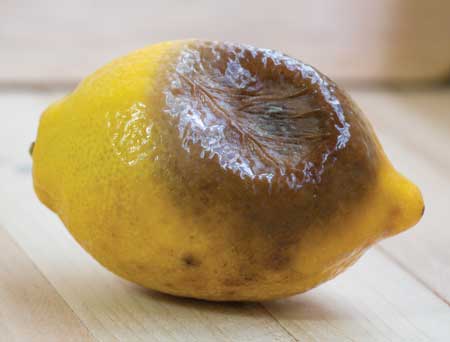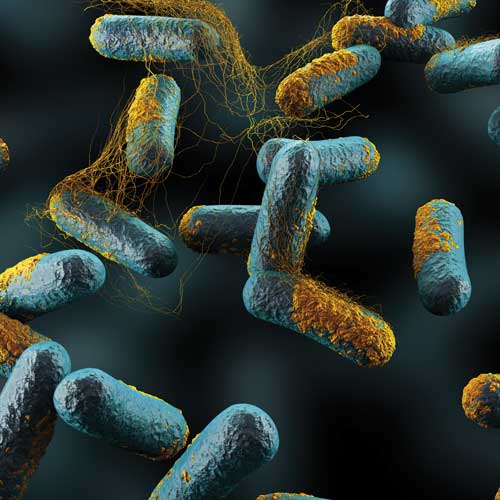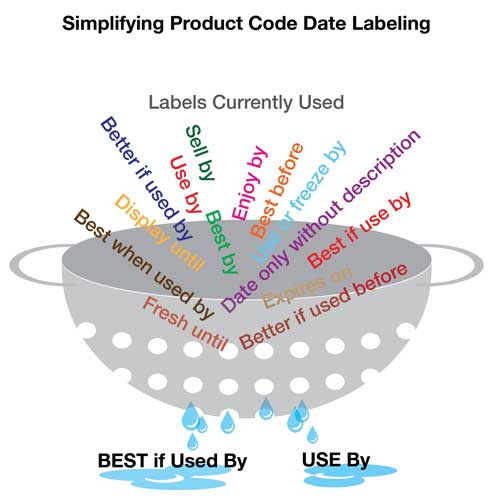The Ick Factor: Microbial Spoilage
FOOD SAFETY AND QUALITY
 A food can be considered spoiled when it is no longer edible or acceptable to consumers or does not meet the quality characteristics that its producer or manufacturer deems optimum. Foods spoil as a result of both natural biochemical changes and changes caused by microorganism growth and metabolism. The latter involves the degradation of proteins, carbohydrates, and fats by microorganisms or microbial enzymes. Signs of spoilage include changes in appearance, taste, odor, and texture. The type of spoilage depends on the original microflora of a product; the product’s physical and chemical characteristics; and how it is processed, packaged, and stored.
A food can be considered spoiled when it is no longer edible or acceptable to consumers or does not meet the quality characteristics that its producer or manufacturer deems optimum. Foods spoil as a result of both natural biochemical changes and changes caused by microorganism growth and metabolism. The latter involves the degradation of proteins, carbohydrates, and fats by microorganisms or microbial enzymes. Signs of spoilage include changes in appearance, taste, odor, and texture. The type of spoilage depends on the original microflora of a product; the product’s physical and chemical characteristics; and how it is processed, packaged, and stored.
Foods and Their Spoilers
Dairy Products. Heterofermentative lactic acid bacteria (LAB) are a group of Gram-positive bacteria, including species of Lactobacillus and Leuconostoc, that produce acid and gas, and under low-oxygen and acidic conditions, certain LAB become the predominant spoilage organisms of a variety of foods. LAB are the predominant bacteria in raw milk. Although refrigeration suppresses growth of LAB, psychrotrophic bacteria such as Pseudomonas can grow and produce rancid or putrid odors. Pasteurization kills LAB and the psychrotrophs, but some spores of Bacillus and Clostridium can survive pasteurization and grow slowly at refrigeration temperatures.
Coliforms can cause rapid spoilage of milk because they are able to ferment lactose with the production of acid and gas and are able to degrade milk proteins. Coliforms are more of a problem in cheese than in milk; they can grow if the starter cultures (LAB) are slow acid producers and produce gas. Most psychrotrophic organisms in milk are destroyed by pasteurization temperatures, but some like Pseudomonas fluorescens and Pseudomonas fragi can produce enzymes that are heat stable and capable of causing spoilage.
Hard and semi-hard cheeses have low moisture content and pH, which limits the growth of some microbes. Some coliforms, Clostridium species, and mold species can grow under these conditions and cause spoilage, most often in the form of gas or, in the case of mold, surface growth. Pseudomonas or Enterobacter can spoil soft cheeses, and Clostridium sporogenes can spoil processed cheese.
Yeasts and molds are the main spoilage organisms in cultured products such as yogurt, sour cream, and buttermilk. Pseudomonas species, yeasts, and molds can spoil butter. Butter’s high fat content and low water activity make it more susceptible to surface mold growth than to bacterial spoilage. Pseudomonas and Enterobacter can cause cream to become rancid. Yeasts, molds, and bacteria can spoil cottage cheese; molds such as Penicillum and Mucor also grow well on cottage cheese.
Eggs. The interior of freshly laid eggs is generally sterile but soon may become contaminated with numerous genera of bacteria that can penetrate the eggshell and cause the egg to spoil. Pseudomonads are common spoilage agents, but molds such as Penicillium and Cladosporium sometimes grow in the air sac and spoil the egg.
 Meat and Poultry. Gram-negative aerobic bacteria such as Pseudomonas, Acinetobacter, and Moraxella are the primary bacteria on fresh meat and poultry and are almost exclusive spoilage agents of ground meat. Bacillus species and clostridia, including Clostridium perfringens, are also common on fresh meat. Some molds can grow on the surface of meat and cause spoilage. Spoilage of poultry is generally the same as for other fresh meats, but off-odors generally appear before sliminess develops.
Meat and Poultry. Gram-negative aerobic bacteria such as Pseudomonas, Acinetobacter, and Moraxella are the primary bacteria on fresh meat and poultry and are almost exclusive spoilage agents of ground meat. Bacillus species and clostridia, including Clostridium perfringens, are also common on fresh meat. Some molds can grow on the surface of meat and cause spoilage. Spoilage of poultry is generally the same as for other fresh meats, but off-odors generally appear before sliminess develops.
The type of spoilage occurring in processed meats such as hot dogs, sausage, and luncheon meats is highly dependent on how they are processed and packaged. Yeasts and bacteria are the most common causes of spoilage of processed meats, and spoilage is characterized by off-odors, greening, and sometimes slime production. The microorganisms involved are usually Pseudomonas, Enterobacteriaceae, Brochothrix thermosphacta, or LAB. Aspergillus, Fusarium, Mucor, Penicillium, Rhizopus, and Botrytis are molds that spoil cured meats such as bacon and ham.
Seafood. On fresh fish, spoilage bacteria tend to grow on the skin, gills, and intestine; the gill region is most susceptible to spoilage. The best way to detect spoilage in fresh fish is by sniffing it to detect off-odors. Shellfish are filter feeders and can contain almost any microorganism that occurs in the water where they were obtained, but once shellfish are removed from clean waters, Pseudomonas, Acinetobacter, and Moraxella can dominate. While sensory examinations are the primary method used by the U.S. Food and Drug Administration (FDA) to determine the decomposed state of seafood, the agency says that histamine in fish and indole in canned, fresh, and frozen shrimp products and canned crab products are two important decomposition indicators that can be used to support sensory results; putrescine and cadaverine are two additional promising indices.
Fruits and Vegetables. Pseudomonas, Erwinia, Bacillus, and Clostridium can cause vegetable spoilage, depending on the type of handling and storage; Erwinia carotovora is the most common spoilage bacteria. Bacterial spoilage (generally described as black, gray, pink, soft, and stem-end rot) first causes softening of tissues as pectins are degraded, and the whole vegetable may eventually degenerate into a slimy mass. Starches and sugars are metabolized next, with development of off-odors and off-flavors and production of lactic acid and ethanol.
Molds belonging to genera such as Rhizopus, Alternaria, and Botrytis cause vegetable rots. Penicillium, Phytophthora, Alternaria, Botrytis, and Aspergillus are involved in spoilage of citrus fruits, apples, pears, and other fruits. Yeasts and molds are more important than bacteria in the spoilage of fruits because most fruits have lower pH and water activity. Since yeasts grow faster than molds, they often initiate fruit spoilage while molds subsequently degrade complex polysaccharides in cell walls and rinds.
Beverages. Beer generally resists bacterial growth, but the bacterial genera Lactobacillus, Pediococcus, Pectinatus, and Megasphaera can generate off-flavors, turbidity, and acidity. Pall Corp.’s GeneDisc Beer Spoilage Bacteria system uses polymerase chain reaction to simultaneously detect and identify 21 major beer spoilage microorganisms in a single run within two hours, allowing fast corrective action and rapid root cause analysis in case of contamination during processing. And Pall Corp.’s GeneDisc Yeast Detection and Identification system enables simultaneous detection and identification of the following major spoilage yeast species in beer: Saccharomyces (cerevisiae, pastorianus, cerevisiae var. diastaticus), Brettanomyces/Dekkera (bruxellensis), Candida/Pichia, Zygosaccharomyces (bailii), Saccharomycodes, and Schizosaccharomyces. Pall Corp.’s yeast detection system is also applicable to wine, which is susceptible to wild yeast and mold growth, particularly Brettanomyces species of yeast, that results in off-taste and off-odor.
Fruit juices generally have relatively high levels of sugar and a low pH, and this favors growth of yeasts, molds, and some acid-tolerant bacteria, resulting in surface mold, cloudiness, and off-flavors. Lack of oxygen in bottled and canned drinks limits or eliminates mold growth, which requires oxygen. However, spoilage yeasts such as Saccharomyces and Zygosaccharomyces are resistant to thermal processing and can grow in canned products. Propionibacterium cyclohexanicum grows in a variety of fruit juices. LAB can spoil orange and tomato juices, and some pseudomonads and Enterobacteriaceae also spoil juices. Alicyclobacillus acidoterrestris is a spoilage bacterium that causes off-flavors in pasteurized juices. Pall Corp.’s GeneDisc TAB Spoilers system provides simultaneous detection of Alicyclobacillus species (acidoterrestris, acidophilus, cycloheptanicus, and herbarius) that are the main potential spoilers of fruit juices.
Testing for Microorganisms
Companies other than Pall Corp. also offer tests for spoilage microorganisms. 3M Food Safety recently announced that its 3M Petrifilm Lactic Acid Bacteria Count Plate has been certified as an AOAC Performance-Tested Method for use with a variety of foods. The certification consisted of an independent laboratory validation of the method, according to a protocol approved by the AOAC Research Institute. The ready-to-use plate simplifies the testing process for LAB spoilage organisms by serving as an all-in-one solution. It eliminates the need for labor-intensive media preparation, special diluents, and sample pH adjustment needed in traditional testing for LAB, which are a concern with respect to meat, fish, poultry, processed foods, produce, dairy products, dressings, and sauces.
Neogen Corp. offers the beverage industry a variety of media for the detection of indicator and spoilage organisms as well as rapid microbiological test kits for yeast, mold, coliforms, and total plate count. And Charm Sciences Inc. offers the Charm EPIC System, a microplate bioluminescence system that measures microbial adenosine triphosphate (ATP) to predict spoilage in shelf-stable, ultra-high-temperature, and extended-shelf-life dairy-based beverages. It also provides ATP hygiene swab tests that measure the total amount of ATP from bacteria, yeasts, molds, biofilms, and food residues on equipment, surfaces, and environmental areas.
Nanotechnology Developments
Nanotechnology continues to be studied as a means of developing smart packages that indicate potential spoilage or shelf life of the products they contain or help control microbial spoilage. A team of European scientists led by Jonathan N. Coleman of Trinity College Dublin has developed printed transistors consisting entirely of two-dimensional nanomaterials that could allow consumer products to gather, process, display, and transmit information. Coleman said that the transistors could unlock the potential for applications such as food packages that display a digital countdown to warn of product spoilage, labels that indicate when wine is at its optimum serving temperature, and even milk cartons that send a message to a cellphone warning that the milk is about to go out of date. The team used standard printing techniques to combine graphene nanosheets as the electrodes with two other nanomaterials as channel and separator to form a working transistor. The team published its results in the April 2017 issue of Science.
Several presenters at IFT17 addressed the use of nanotechnology to reduce waste due to microbial spoilage of packaged foods. During the symposium “Nano-Enabled Packaging to Increase Food Safety and Decrease Food Waste,” Tony Jin of the U.S. Dept. of Agriculture’s (USDA) Agricultural Research Service discussed the antimicrobial activity of nanoparticles and nanoemulsions in food packaging against foodborne pathogens and spoilage microorganisms, and Umut Yucel of Kansas State University discussed use of nanoemulsions to deliver essential oils with improved antimicrobial effect against spoilage and pathogenic microorganisms.
Researchers led by Silvana Andreescu at Clarkson University are developing paper-based sensors that change color as foods and cosmetics go bad. The sensors bind to the reactive oxygen species that products accumulate as they age and eventually spoil. Reporting at the American Chemical Society’s national meeting in August 2017, Andreescu said that this technology could one day be incorporated into smart labels that would tell consumers when to discard a product. Each sensor incorporates all the needed reagents for detection in a piece of paper and is adaptable to different targets, including food contaminants, antioxidants, and free radicals that indicate spoilage. While most other sensors use solutions that migrate on channels, Andreescu said, their sensors use nanostructures and stable inorganic particles that are redox active and change color when they interact with target substances; the intensity of the change tells how concentrated each analyte is.
Shelf Life and Date Labeling
Food and beverage companies determine the shelf life of their products by monitoring the physical, chemical, and microbial changes that occur during storage under a variety of conditions, including temperature, humidity, length of storage time, and packaging. They can measure the growth of microorganisms or use predictive modeling to predict the growth. Predictive modeling involves computer simulation of the growth of microorganisms in foods in response to temperature, pH, oxygen levels, and other factors to predict such parameters as lag time and time to reach a specific level. Among the various models that are available are the Predictive Microbiology Information Portal by the USDA; ComBase, developed by the USDA’s Agricultural Research Service and the University of Tasmania; and Campden BRI’s Forecast system, which provides models for fish, meat, fresh produce, fruits, beverages, and acidified foods.
 Food companies use the shelf life information to indicate via date labeling when the product should be consumed for best quality. According to the Trading Partner Alliance (TPA), a collaboration of grocery manufacturers and retailers led by the Grocery Manufacturers Association and the Food Marketing Institute, more than 10 different statements are being used on packages, including “Sell By,” “Use By,” “Expires On,” “Best Before,” “Better if Used By,” and “Best By.” This can result in consumers discarding a safe or usable product, the TPA said, adding that about 44% of food waste sent to landfills comes from consumers and that addressing consumer confusion around product date labeling could reduce total national food waste by 8%.
Food companies use the shelf life information to indicate via date labeling when the product should be consumed for best quality. According to the Trading Partner Alliance (TPA), a collaboration of grocery manufacturers and retailers led by the Grocery Manufacturers Association and the Food Marketing Institute, more than 10 different statements are being used on packages, including “Sell By,” “Use By,” “Expires On,” “Best Before,” “Better if Used By,” and “Best By.” This can result in consumers discarding a safe or usable product, the TPA said, adding that about 44% of food waste sent to landfills comes from consumers and that addressing consumer confusion around product date labeling could reduce total national food waste by 8%.
The TPA announced in 2017 an industry-wide effort to reduce consumer confusion about product date labels, recommending that manufacturers and retailers voluntarily adopt standard wording on packaging about the quality and safety of products. The TPA issued the white paper “Product Code Date Labeling: Crucial Initiative to Reduce Consumer Confusion” and the “Product Code Date Labeling Implementation Guide,” which recommends use of just two standard phrases: “BEST If Used By” (or “BEST If Used By or Frozen By”) to indicate the date at which the product may not taste or perform as expected but is still safe to consume and “USE By” (or “USE or Freeze By”) to indicate the date by which the product should be consumed or discarded because it is highly perishable and may have a safety concern over time. The guide also suggests modifications for different package sizes. The new voluntary industry standard matches the recommendation for “Best if Used By” from the USDA’s Food Safety and Inspection Service.
Recognizing that consumer practices at home, including storage, handling, and preparation of foods, are important to maintaining freshness and quality, the TPA referenced the FoodKeeper app, which is intended to help consumers learn how to store foods and beverages to maximize their freshness and quality. Available at FoodSafety.gov, the app was developed by the USDA’s Food Safety and Inspection Service with Cornell University’s department of food science. It provides information on shelf life, handling, food safety, and storage of more than 400 refrigerated, frozen, and shelf-stable foods.
 Neil H. Mermelstein, IFT Fellow,
Neil H. Mermelstein, IFT Fellow,
Editor Emeritus of Food Technology
[email protected]


